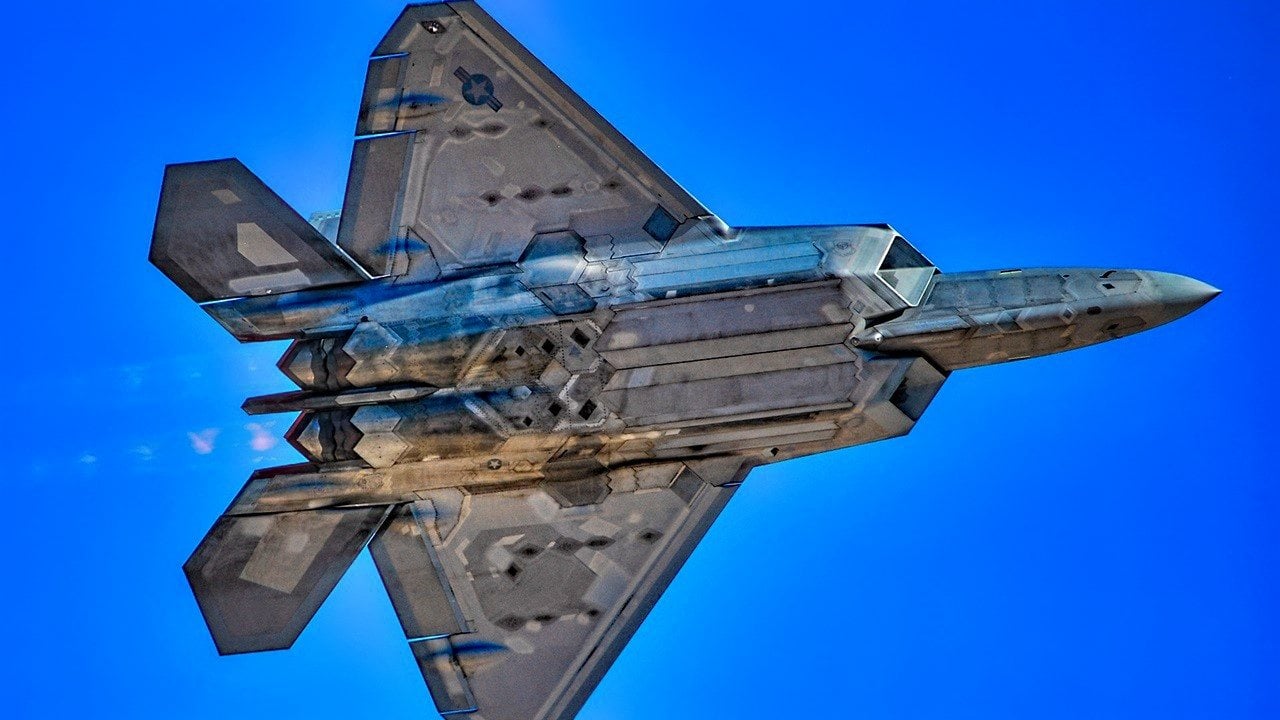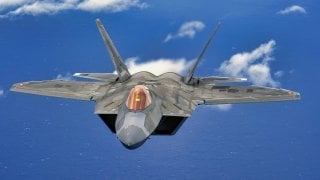The Secret Reason an F-22 Raptor was 'Defeated' by a Eurofighter Typhoon
In the 2012 Red Flag exercises, German Eurofighter Typhoons reportedly bested the U.S. Air Force's F-22 Raptors in mock dogfights. While this stirred debate, the results were influenced by specific conditions, including close-range visual combat and F-22s carrying external fuel tanks, reducing their stealth and maneuverability.
What You Need to Know: In the 2012 Red Flag exercises, German Eurofighter Typhoons reportedly bested the U.S. Air Force's F-22 Raptors in mock dogfights. While this stirred debate, the results were influenced by specific conditions, including close-range visual combat and F-22s carrying external fuel tanks, reducing their stealth and maneuverability.

-The exercises highlighted the advantages of lower-tech systems under certain conditions.
-However, these contrived scenarios don’t negate the F-22's technological superiority. Despite these results, subsequent wargames and analyses consistently demonstrate the F-22’s unmatched capabilities in over-the-horizon engagements and its critical role in potential conflicts with near-peer competitors.
That Time Eurofighter Typhoons Beat F-22 Raptors
Wargames are often a very informative experience, if the gamemasters let things play out as the players intend. Oftentimes, they are rigged events for political purposes. In the case of the 2012 Red Flag exercises which pitted German Eurofighter Typhoons, a European-built fourth-generation warplane, against fifth-generation F-22A Raptors, the Eurofighters managed to defeat the F-22s.
There’s a key debate that has raged in defense and technology circles as to whether systems belonging to high-tech domain or the low-tech domain would win. Naturally, most assume that the high-tech wins ever time.
Yet, the F-22, probably the most advanced warplane in the world, has proven itself to be vulnerable to attack from lower-tech adversaries. In the case of the Red Flag exercises in 2012, the Eurofighters got in close to the F-22s and were able to outmaneuver the fifth-generation warplanes at close range.
Indeed, this has been a key weakness in fictionalized engagements between the F-22s and fourth-generation warplanes.
The Eurofighter and the F-22
Eurofighter Typhoons, like the F-22A Raptor, were designed to do air superiority missions for their respective air forces. The Typhoon came out in 1994. The F-22 came out in 1997. It entered service in 2005 whereas the Eurofighter Typhoon entered service in 2003. So, these birds came out concurrently.
Nevertheless, the F-22 is the superior plane technologically. The F-22 is the world’s greatest stealth warplane that fuses stealth with incredible situational awareness. In theory, this allows for the F-22 to engage enemies in the distance.
On the other hand, the Eurofighter’s design was not revolutionary in the way the F-22 was. It was intended to merely perfect the already excellent fourth-generation warplane design. The Eurofighter had a delta-shaped configuration. Although not stealthy in the way that the F-22 is, the Eurofighter does employ cross-section-reducing technologies as well as electronic warfare capabilities meant to aid in keeping the Eurofighter off radar screens.
To be clear, the F-22, when fully operational is a technologically superior bird. But its complexity makes it both expensive and difficult to maintain. The Eurofighter, while not cheap, is far cheaper than the F-22. Its maintenance costs are a fraction of what the F-22’s maintenance costs are (because its systems are nowhere near as advanced). The Typhoons have a modular design that basically make for a simple plug-and-play model when it comes to armaments and capabilities.
What Happened?
Like so many controversial wargames, the scenarios in which the superior system was bested by an inferior one were contrived. In this case, according to Alex Hollings, the engagements between the F-22 and Eurofighters were one-on-one. What’s more, “they occurred within visual range with a number of reports stating that the Raptor was carrying stealth-hindering external fuel tanks.”
So, the Eurofighters could detect and track the F-22s when, under ordinary conditions, they’d be unable to.
There’s another problem with this contrived wargame scenario: over-the-horizon capabilities. Further reports about the exercise from more than a decade ago indicate that the F-22s may have started the exercises in the defensive position, meaning they were inherently disadvantaged. The F-22s were prevented by the game rules to engage the Eurofighters from over-the-visual-horizon (which is where the F-22 strengths lie, especially when faced against fourth-generation birds).
Plus, those aforementioned external fuel tanks ensured that the F-22s were less maneuverable than the Eurofighters were.
In all, the 2012 Red Flag exercises were an unfair test of the F-22’s capabilities. But look at the context of what was occurring back then. The world was just a little more than a year removed from what was then the controversial decision by the Obama administration to prematurely discontinue the F-22 Raptor production line.
Because of that decision, the Obama administration forced America to rely upon the other fifth-generation warplane, the F-35 Lightning II. Critics of the F-22 were seemingly vindicated by the decision and the wargame results only validated their criticisms even more.

Frankly, the decision to terminate the F-22’s production line prematurely was foolish. The F-22 is the superior warplane in America’s arsenal. The fact that some foreign fourth-generation warplanes, such as the Eurofighter, were able to best the F-22 in a wargame is meaningless.
Especially when subsequent wargames conducted by RAND Corporation and others show that the introduction of F-22s into war against Chinese forces fundamentally alters the balance of power in America’s favor for those theoretical engagements.
The Eurofighters got lucky. Don’t read too much into that.
Author Experience and Expertise: Brandon J. Weichert
Brandon J. Weichert, a National Interest national security analyst, is a former Congressional staffer and geopolitical analyst who is a contributor at The Washington Times, the Asia Times, and The-Pipeline. He is the author of Winning Space: How America Remains a Superpower, Biohacked: China’s Race to Control Life, and The Shadow War: Iran’s Quest for Supremacy. His next book, A Disaster of Our Own Making: How the West Lost Ukraine, is due October 22 from Encounter Books. Weichert can be followed via Twitter @WeTheBrandon.
All images are Creative Commons or Shutterstock.
From the Vault


